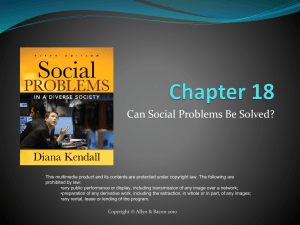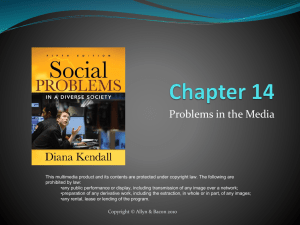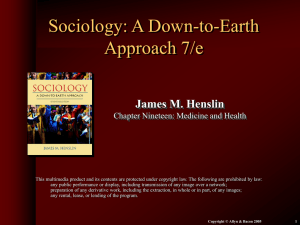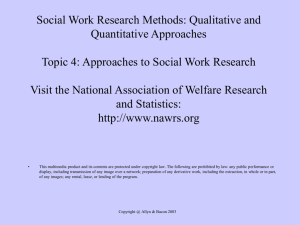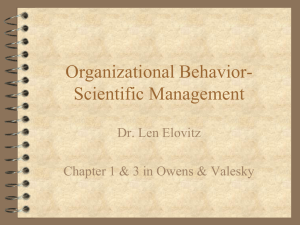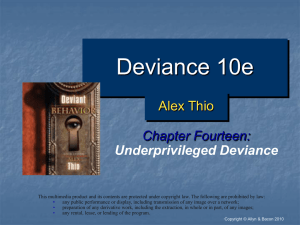Chapter 3
advertisement
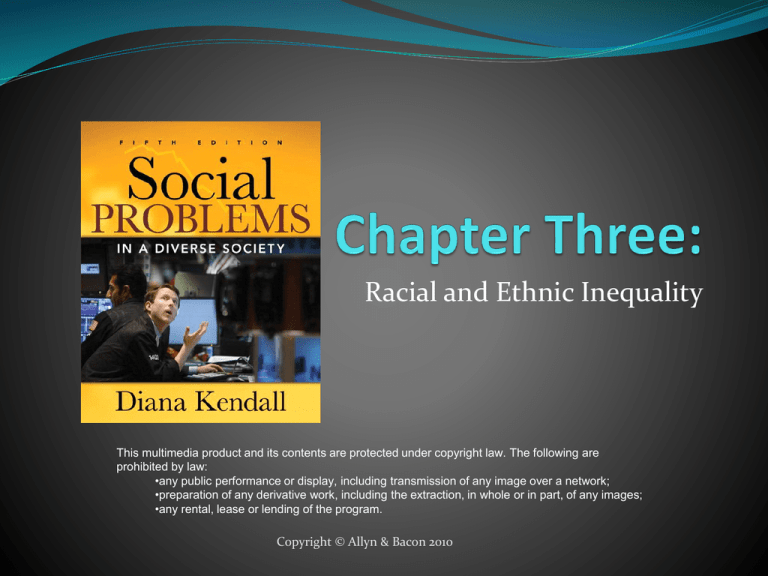
Racial and Ethnic Inequality This multimedia product and its contents are protected under copyright law. The following are prohibited by law: •any public performance or display, including transmission of any image over a network; •preparation of any derivative work, including the extraction, in whole or in part, of any images; •any rental, lease or lending of the program. Copyright © Allyn & Bacon 2010 Chapter 3 Outline Basic Definitions • Racial Group • Ethnic Group • Dominant vs. Subordinate Group Social Behavior Sociological Perspectives on Race Inequalities among racial & ethnic groups • Racism • Prejudice • Individual and Institutional discrimination • • • • Social –Psychological Symbolic Interactionist Functionalist Conflict • Native Americans • African Americans • Latinos (Hispanic Americans) • Asian and Pacific Americans Copyright © Allyn & Bacon 2010 Defining race Biological definition of race: Population differs from another because of some genes. Today no “pure” races exist due to generations of intermixing. Sociologists view race as a social construct Classification based on social and political values Copyright © Allyn & Bacon 2010 Racial Group A racial group is: A category of people who have been singled out Seen as inferior or superior than other groups Determined by subjectively defined physical characteristics (such as skin color, hair texture, eye shape). Examples of Racial Groups African Americans Native Americans Copyright © Allyn & Bacon 2010 Asian Americans Ethnic Group An Ethnic Group is: A group distinguished from others. Seen as inferior or superior. Distinguished on the basis of cultural or nationality characteristics. Characteristics of an ethnic group Unique cultural characteristics Sense of community Belief your group is best Copyright © Allyn & Bacon 2010 Born into category Tendency to occupy distinct area Dominant and Subordinate Groups Dominant Group: Subordinate Group: Advantaged compared to Are disadvantaged compared other groups in society Have superior resources and rights in a society Can be determined by race, ethnicity, gender, sexual orientation, or other factors In the U.S. the dominant group is associated with white-skin privilege. to other groups Face unequal treatment, prejudice, or discrimination See themselves as objects of discrimination Copyright © Allyn & Bacon 2010 Racism and Prejudice Racism: beliefs and practices which justify unequal treatment of racial and ethnic groups. White racism is present in the U.S. and denies people of color opportunities. Prejudice: negative attitude toward a particular group. Based on faulty generalizations Stems from ethnocentrism (assumption one’s group is superior) Also influenced by stereotypes (overgeneralizations about all members of a group.) Copyright © Allyn & Bacon 2010 Discrimination Individual Discrimination: One on one acts against subordinate group by dominant group. Generally stems from prejudice. Institutional Discrimination: Involves day to day practices of institutions. results in harmful impact on subordinate group members. Copyright © Allyn & Bacon 2010 Sociological Perspectives on Race Social Psychological Perspective: Frustration-aggression hypothesis: Individuals who are unable to achieve a set goal become frustrated Individuals then develop aggression Aggression taken out on scapegoat (person blamed for causing the problem can either be real or perceived.) Authoritarian Personality: Tendency to be more prejudice See world as threatening and are intolerant of subordinate groups Copyright © Allyn & Bacon 2010 Symbolic Interactionist Racial Socialization: Process of social interaction containing messages about one’s racial/ethnic group. Can be direct via contact with parents, peers, teachers, others Also indirectly through media images Copyright © Allyn & Bacon 2010 Functionalist: Focus on social order and stability as being important. Assimilation: Process where subordinate group members become absorbed in dominant culture Seen by functionalists as stabilizing In complete form it becomes amalgamation (melting pot; characteristics of different groups blend together into new group) Anglo-conformity model: assimilation whereby subordinate group is expected to conform to AngloSaxon population Copyright © Allyn & Bacon 2010 Functionalist (cont.) Ethnic Pluralism: Diverse racial and ethnic groups coexist Maintain separate identities and cultures Segregation: Spatial and social separation of people Based on race/ethnicity, class, gender, religion or other social characteristics. Copyright © Allyn & Bacon 2010 Conflict Class perspectives: Historically African Americans were enslaved because they were the cheapest and best workers Contemporary theory Split-labor market theory: U.S. economy divided into 2 sectors. Primary sector: higher paid workers with job security Secondary sector: lower paid workers in more hazardous jobs. Dominant group generally in primary sector Subordinate group generally in secondary sector Copyright © Allyn & Bacon 2010 Conflict (cont.) Gendered Racism: Interaction of gender and race resulting in exploitation of woman of color. Women of color face double discrimination in labor force. Internal Colonialism: Members of a racial/ethnic group are placed under control of the dominant group. Racial/ethnic groups who have experienced this remain in subordinate positions longer than those who haven’t. Copyright © Allyn & Bacon 2010 Conflict (cont.) Theory of racial formation: Government has large role in defining racial and ethnic relations. Policies and actions placing one group in a subordinate position Immigration and naturalization laws also influence relations between racial and ethnic groups. Copyright © Allyn & Bacon 2010 Racial Composition in the U.S. Copyright © Allyn & Bacon 2010 Native Americans Population of 15 million inhabited land when Columbus arrived in 1492. White Europeans conquered and colonized the Native Americans Engaged in genocide (deliberate killing of a people) 1830: Indian Removal Act passed: Became wards of the government “Trail of tears” Children were Americanized. Copyright © Allyn & Bacon 2010 Native Americans (cont.) Today Native Americans: Make up 1.5% of population 1/3 live on reservations Are the most disadvantaged racial/ethnic group in the U.S. Have high rates of unemployment, school dropout, suicide and infant mortality. Copyright © Allyn & Bacon 2010 African Americans First brought to North American as slaves in 1619. Slavery abolished in 1863: In South: de jure segregation- laws that enforced segregation In North: de facto segregation- separation and inequality due to custom. Civil Rights Acts of 1964 and 1965 ended de jure segregation. Copyright © Allyn & Bacon 2010 African Americans (cont.) Today African Americans: Make up 13% of population Have made significant political gains Still face significant discrimination in many areas of society. Are portrayed stereotypically as “welfare mothers” and “criminals” Copyright © Allyn & Bacon 2010 Latinos (Hispanic Americans) Puerto Rico became a U.S. possession in 1917 and citizens allowed unrestricted migration to U.S. In late 1950’s refugees immigrated to U.S. from Cuba to flee from Fidel Castro’s communist takeover. Mexicans have immigrated to the U.S. when there has been a need for agricultural workers Copyright © Allyn & Bacon 2010 Latinos (cont.) Today Latinos: Are growing in number in the U.S. Have a high poverty rate Have a high unemployment rate Still face significant discrimination in many areas of society. Depicted by media as drug lords or illegal aliens. Copyright © Allyn & Bacon 2010 Asian and Pacific Americans Chinese workers came to America between 1850 and 1880. Chinese Exclusion Act of 1882 ended immigration Japanese immigrants forced into internment camps during WWII. Today many highly educated professional immigrating from India and Pakistan. Many immigrants have come recently from other parts of Asia (Vietnam, Thailand, and others) Hawaiian Islands became 50th state in 1959 (many people of Asian decent inhabit the islands) Copyright © Allyn & Bacon 2010 Asian and Pacific Americans (cont.) Today Asian and Pacific Americans: Have high educational levels Have high median income levels Have relatively low poverty rates Copyright © Allyn & Bacon 2010 Median Family income Copyright © Allyn & Bacon 2010 Solutions to Racial and Ethnic Inequality Functionalist: Restructure Social Institutions Conflict: Struggle and Political Action Interactionist: Teach cultural diversity to unlearn prejudice and discrimination Copyright © Allyn & Bacon 2010



